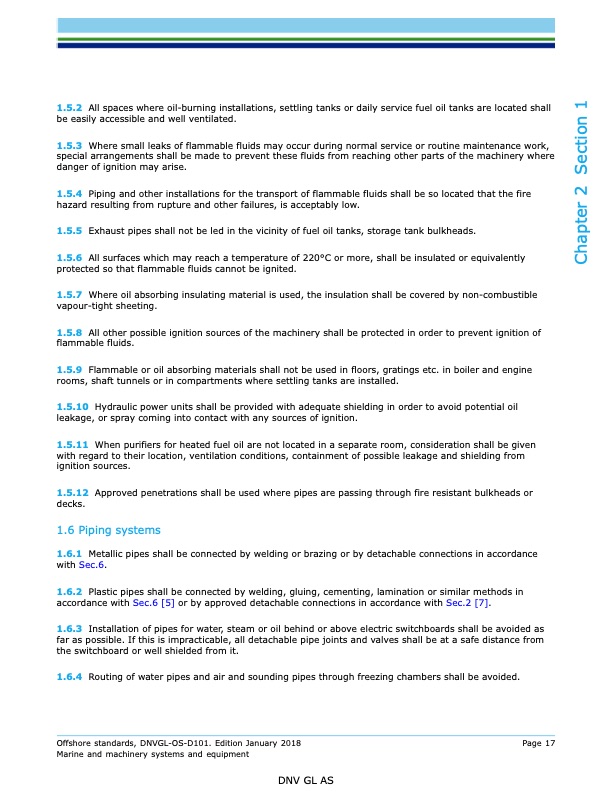
PDF Publication Title:
Text from PDF Page: 017
1.5.2 All spaces where oil-burning installations, settling tanks or daily service fuel oil tanks are located shall be easily accessible and well ventilated. 1.5.3 Where small leaks of flammable fluids may occur during normal service or routine maintenance work, special arrangements shall be made to prevent these fluids from reaching other parts of the machinery where danger of ignition may arise. 1.5.4 Piping and other installations for the transport of flammable fluids shall be so located that the fire hazard resulting from rupture and other failures, is acceptably low. 1.5.5 Exhaust pipes shall not be led in the vicinity of fuel oil tanks, storage tank bulkheads. 1.5.6 All surfaces which may reach a temperature of 220°C or more, shall be insulated or equivalently protected so that flammable fluids cannot be ignited. 1.5.7 Where oil absorbing insulating material is used, the insulation shall be covered by non-combustible vapour-tight sheeting. 1.5.8 All other possible ignition sources of the machinery shall be protected in order to prevent ignition of flammable fluids. 1.5.9 Flammable or oil absorbing materials shall not be used in floors, gratings etc. in boiler and engine rooms, shaft tunnels or in compartments where settling tanks are installed. 1.5.10 Hydraulic power units shall be provided with adequate shielding in order to avoid potential oil leakage, or spray coming into contact with any sources of ignition. 1.5.11 When purifiers for heated fuel oil are not located in a separate room, consideration shall be given with regard to their location, ventilation conditions, containment of possible leakage and shielding from ignition sources. 1.5.12 Approved penetrations shall be used where pipes are passing through fire resistant bulkheads or decks. 1.6 Piping systems 1.6.1 Metallic pipes shall be connected by welding or brazing or by detachable connections in accordance with Sec.6. 1.6.2 Plastic pipes shall be connected by welding, gluing, cementing, lamination or similar methods in accordance with Sec.6 [5] or by approved detachable connections in accordance with Sec.2 [7]. 1.6.3 Installation of pipes for water, steam or oil behind or above electric switchboards shall be avoided as far as possible. If this is impracticable, all detachable pipe joints and valves shall be at a safe distance from the switchboard or well shielded from it. 1.6.4 Routing of water pipes and air and sounding pipes through freezing chambers shall be avoided. Offshore standards, DNVGL-OS-D101. Edition January 2018 Page 17 Marine and machinery systems and equipment DNV GL AS Chapter 2 Section 1PDF Image | Marine and machinery systems and equipment 2018

PDF Search Title:
Marine and machinery systems and equipment 2018Original File Name Searched:
DNVGL-OS-D101.pdfDIY PDF Search: Google It | Yahoo | Bing
Development of a solar powered Electric Ship The Electricship website originally started off as a project to develop a comprehensive renewable, affordable, modular electric ship... More Info
Modular Boat Hull Composite The case for a unsinkable, modular composite hybrid boat hull... More Info
MS Burgenstock Hybrid Electric Catamaran Lake Lucerne Unique shuttle servicing Lucerne to the Burgenstock Resort... More Info
Ground Power Unit GPU Powered by Lithium Ion Batteries The goal of the Ground Power Unit is to provide a readily accessible, modular, ready-to-power solution for remote power... More Info
| CONTACT TEL: 608-238-6001 Email: greg@electricship.com | RSS | AMP |